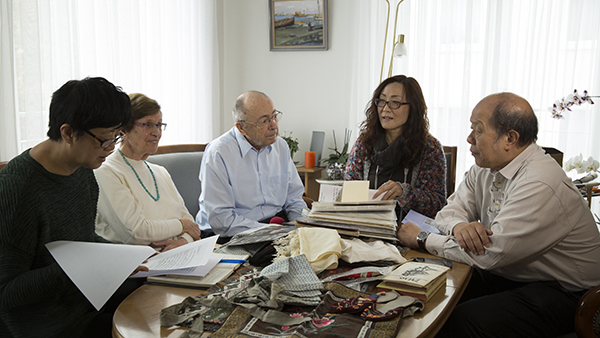One of the features of the Longhua (Dalang) Sub-venue of the UABB will be an exhibition of artifacts that were taken back to Switzerland, when the missionaries left China in 1948. To learn more about the Basel Mission and their “Chinese children,” please read the rest of the article. The artifacts will be on display at the Longheu P+V Gallery from December 22, 2017 through December 4, 2018.
Popular accounts of Shenzhen’s migrant history frequently overlook the era of missionary expansion. However, this era has been reintroduced to the city through the restoration and renovation of the Longheu Girls’ School and Church. Located in Langkou Village, Dalang Subdistrict, the Girls’ School has been repurposed as the Longheu P+V Gallery. The Gallery’s name combines the English and Chinese names of the Girls’ School. The English name romanized Langkou as “Longheu,” which was the Hakka pronunciation of the village. The Chinese name of the Girls’ School was Pious Virgins Girls’ School.

Longheu P+V Gallery, photography by Leng Jiang
From 1847 to 1949, the Basel Mission sent nearly 200 missionaries to “Hakkaland” in Guangdong. They set up their headquarters at Lilang (near Buji, Shenzhen), where they eventually built a seminary. In Shenzhen, they built elementary schools in Zhangkangjing, Langkou, and Kuichong. From Lilang, the mission spread along the Pearl, East, and Mei Rivers, reaching into Huizhou, Heyuan, Meizhou, and Xingning, where they proselytized and built schools and hospitals. At its most active, the Hakkaland mission was partitioned into the lowlands (unterland) with its headquarters at Lilang and highlands (oberland) with its headquarters at Wuhua, Meizhou. According to statistics from 1927, the Basel Mission established 174 institutions in Hakkaland, including the seminary, two hospitals, a nursing school, a women’s normal college, and preaching school in addition to over one hundred schools that provided elementary and high educations. The schools had the greatest impact on Guangdong’s poorest villages, giving children from remote areas access to modern education and through this education, an opportunity to make their way in the world.

Lilong Theological Seminary, photograph curtesy of the Basel Mission Archive

Zhangkangjing Boys’ School, photograph curtesy of the Basel Mission Archive

Longheu Girls’ School, photograph curtesy of the Basel Mission Archive

Kuichong Primary School, photograph curtesy of the Basel Mission Archive
During the missionary century, these westerners not only brought the gospel, but also scientific, medical, pedagogical, and ideological advances, specifically the concept of gender equality. These missionaries migrated to Hakkaland, living with villagers during one of China’s most volatile centuries. They incorporated Hakka culture into their lives and their memories of Hakkaland shaped their European lives.

Missionaries and Hakka converts, photograph curtesy of the Basel Mission Archive

Missionaries and Hakka converts, photograph curtesy of the Basel Mission Archive
During the writing and documentary filming of The Longheu Girls’ School, we contacted the decedents of missionaries who had worked in China. A considerable number of them were born in Shenzhen, Meizhou, and Heyuan—what they knew as Hakkaland. In 1949, they returned with their parents to Switzerland or Germany, where they called themselves “Chinese children.” Now in their 80s and 90s, they remember Hakka villages and have carefully preserved objects from their parents’ missionary lives—household objects, letters, and books from China.

Missionary children’s impressions of leaving China, photograph by Gu Suying
In conversation with the Swiss and German “Chinese children” it is easy to hear the traces of their Hakka youth. Their home furnishings, their personal collections, their temperament, their dress, and their use of Hakka language, reveal traces of Hakka customs. Members of the P+V Historical Association visited Switzerland and Germany three times in order to track this forgotten history. In a beautiful and tranquil European village, we listened to the “Chinese children” tell their stories, which in turn highlighted the personal aspect of larger historical transformations.

Interview with Earnst Itten, photograph by Zhu Mingliang

Interview with Hildegard and Hermann Glasle, photograph by Zhu Mingliang
The Longheu Girls’ School bore witness to this history. Today, the Longheu P+V Gallery is entrusted with the task of organizing Sino-Swiss historical and cultural exchanges and exploring how western with Hakka culture influenced each other. The P+V Historical Association has curated an exhibition of the artifacts that the Hakkaland missionaries brought back to Switzerland and Germany. This exhibition will be on display as part of the Longhua (Dalang) Subvenue Exhibition of the 2017 Shenzhen-Hong Kong Bi-City Biennale of Urbanism\Architecture.
The efforts of the P+V to record and shed light on these little known histories aim to make clear the complex migrations of history and culture that have shaped both Hakkaland and German speaking Europe.

Thank you for sharing. May i ask where can i watch The Longheu Girls’ School? I just found out that my ancestors were from Long Heu village.
Youtube, search 《虔贞女校》。 All three episodes are online.